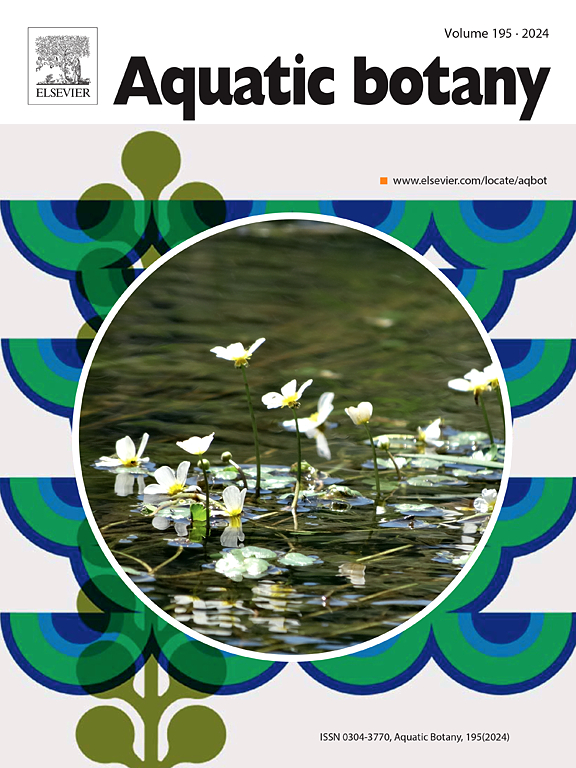基于形态和分子资料的亚属间杂交种荆草×微卡彭(斑草科)的首次发现
IF 2.6
4区 生物学
Q2 MARINE & FRESHWATER BIOLOGY
引用次数: 0
摘要
杂交在米草属中很普遍,但以前确认的病例仅限于两个亚属(亚属)内的种之间的杂交。黄米属或亚属。Sparganium)。亚属间杂交长期以来一直被大多数权威研究人员所忽视,因为交叉这些谱系的实验尝试总是失败。本文报道了一种新发现的天然杂交种Sparganium × papczenkovii Belyakov et Lapirov,该杂交种是由两个Sparganium亚属的种间自发杂交而成的。黄花菜属植物)和小果皮属植物。Sparganium)。通过7个形态特征的主坐标分析,证实了该群体的杂交地位,包括比较杂交种及其推测的亲本种(S. emersum和S. microcarpum)的花被形态计量学,以及另一个可能的候选物种- S. erectum。叶绿体和细胞核DNA的序列分析进一步支持了杂交来源,结果表明,所有样品均与母本为emersum,父本为S. microcarpum杂合。我们还发现所有的S. × papczenkovii样品都是F1代。我们认为,合子后的生殖隔离,特别是F1的不育,可能维持了沙棘和小角沙棘之间的物种边界。尽管具有潜在的不育性,但Sparganium的F1杂交种表现出显著的生态和进化相关性,因为它们的营养繁殖通常赋予它们比亲本物种更高的竞争力。本文章由计算机程序翻译,如有差异,请以英文原文为准。
First discovery of an intersubgeneric hybrid Sparganium emersum × S. microcarpum (Typhaceae) based on morphological and molecular data
Hybridization is widespread in the genus Sparganium, but previously confirmed cases were restricted to crosses between species within the two subgenera (subg. Xanthosparganium or subg. Sparganium). Intersubgeneric hybridization had long been dismissed by most authoritative researchers, as experimental attempts to cross these lineages consistently failed. Here we reported Sparganium × papczenkovii Belyakov et Lapirov, a newly discovered natural hybrid resulting from the spontaneous hybridization between species of two Sparganium subgenera: S. emersum (subg. Xanthosparganium) and S. microcarpum (subg. Sparganium). The hybrid status of the found population was confirmed through principal coordinates analysis of seven morphological traits including tepal morphometrics comparing the hybrid, its putative parental species (S. emersum and S. microcarpum), and one more possible candidate – S. erectum. Sequence analysis of chloroplast and nuclear DNA further supported the hybrid origin, revealing that all examined S. × papczenkovii samples were heterozygous with S. emersum as the maternal parent and S. microcarpum as the paternal parent. We also found that all samples of S. × papczenkovii were F1 generations. We propose that post-zygotic reproductive isolation specifically, F1 sterility may maintain species boundary between S. emersum and S. microcarpum. Despite potential sterility, F1 hybrids in Sparganium exhibit significant ecological and evolutionary relevance, as their vegetative reproduction often grants them higher competitiveness compared to parental species.
求助全文
通过发布文献求助,成功后即可免费获取论文全文。
去求助
来源期刊

Aquatic Botany
生物-海洋与淡水生物学
CiteScore
3.80
自引率
5.60%
发文量
70
审稿时长
6 months
期刊介绍:
Aquatic Botany offers a platform for papers relevant to a broad international readership on fundamental and applied aspects of marine and freshwater macroscopic plants in a context of ecology or environmental biology. This includes molecular, biochemical and physiological aspects of macroscopic aquatic plants as well as the classification, structure, function, dynamics and ecological interactions in plant-dominated aquatic communities and ecosystems. It is an outlet for papers dealing with research on the consequences of disturbance and stressors (e.g. environmental fluctuations and climate change, pollution, grazing and pathogens), use and management of aquatic plants (plant production and decomposition, commercial harvest, plant control) and the conservation of aquatic plant communities (breeding, transplantation and restoration). Specialized publications on certain rare taxa or papers on aquatic macroscopic plants from under-represented regions in the world can also find their place, subject to editor evaluation. Studies on fungi or microalgae will remain outside the scope of Aquatic Botany.
 求助内容:
求助内容: 应助结果提醒方式:
应助结果提醒方式:


